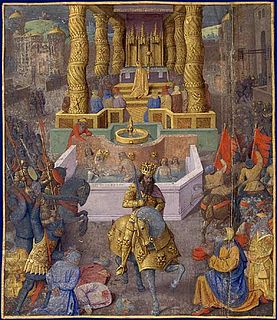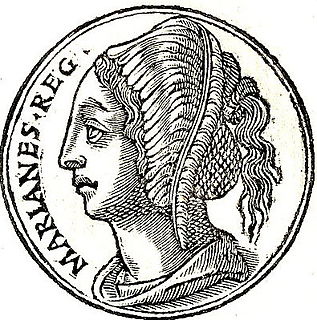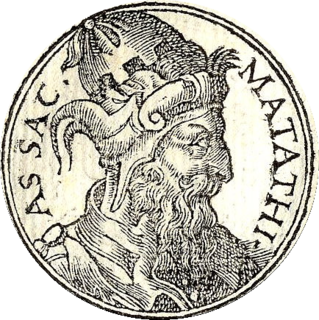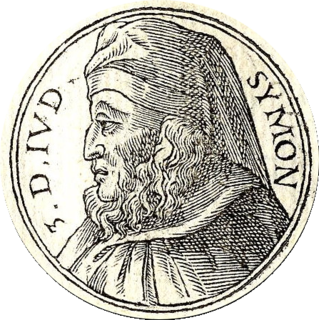 W
WThe Hasmonean dynasty was a ruling dynasty of Judea and surrounding regions during classical antiquity, from c. 140 BCE to 37 BCE. Between c. 140 and c. 116 BCE the dynasty ruled Judea semi-autonomously from the Seleucid Empire, and from roughly 110 BCE, with the empire disintegrating, Judea gained full independence and expanded into the neighboring regions of Samaria, Galilee, Iturea, Perea, and Idumea. The Hasmonean rulers took the title "basileus,, and some modern scholars refer to this period as an independent kingdom of Israel. The kingdom was ultimately conquered by the Roman Republic and the dynasty was displaced by Herod the Great in 37 BCE.
 W
WSalome Alexandra or Alexandra of Jerusalem, was one of only two women to rule over Judea. The wife of Aristobulus I, and afterward of Alexander Jannaeus, she was the last queen of Judea, and the last ruler of ancient Judea to die as the ruler of an independent kingdom from 76 to 67 BCE.
 W
WAntigonus II Mattathias, also known as Antigonus the Hasmonean was the last Hasmonean king of Judea. A puppet king installed by the Parthians, he was the son of King Aristobulus II of Judea. In 37 BCE Herod handed him over to the Romans for execution, after Antigonus's three-year reign during which he led the Jews' fierce struggle for independence against the Romans.
 W
WJudah Aristobulus I or Aristobulus I was the first Hasmonean king of Judaea from 104 BCE until his death in 103 BCE. He was the eldest of the five sons of John Hyrcanus, the previous leader. Aristobulus's Hebrew name was Judah. He was also referred to as "Philhellene", meaning he was an admirer of Greek culture. Josephus states that he was the first Jew in "four hundred and eighty three years and three months" to have established a monarchy since the return from the Babylonian Captivity.
 W
WAristobulus II was the Jewish High Priest and King of Judea, 66 BCE to 63 BCE, from the Hasmonean Dynasty.
 W
WEleazar Avaran, also known as Eleazar Maccabeus, Eleazar Hachorani/Chorani was the fourth son of Mattathias and the younger brother of Judas Maccabeus. He was killed at the Battle of Beth-zechariah during the Maccabean revolt.
 W
WHasmonean coinage are the coins minted by the Hasmonean kings. Only bronze coins in various denominations have been found; the smallest being a prutah or a half prutah. Two Roman silver denarii are associated with the Hasmoneans; one has the inscription BACCIVS IVDAEAS; with its exact meaning unclear. Both show a man thought to be Yehuda Aristobolus bowing before a camel with a palm branch in his hand.
 W
WJohn Hyrcanus II, a member of the Hasmonean dynasty, was for a long time the Jewish High Priest in the 1st century BCE. He was also briefly King of Judea 67–66 BCE and then the ethnarch (ruler) of Judea, probably over the period 47–40 BCE.
 W
WJohn Hyrcanus was a Hasmonean (Maccabean) leader and Jewish high priest of the 2nd century BCE. In rabbinic literature he is often referred to as Yoḥanan Cohen Gadol, "John the High Priest".
 W
WAlexander Jannaeus was the second king of the Hasmonean dynasty, who ruled over an expanding kingdom of Judea from 103 to 76 BCE. A son of John Hyrcanus, he inherited the throne from his brother Aristobulus I, and married his brother's widow, Queen Salome Alexandra. From his conquests to expand the kingdom to a bloody civil war, Alexander's reign has been generalised as cruel and oppressive with never-ending conflict. The major historical sources of Alexander's life are Josephus's Antiquities of the Jews and The Jewish War.
 W
WHerod the Great's Siege of Jerusalem was the final step in his campaign to secure the throne of Judea. Aided by Roman forces provided by Marcus Antonius, Herod was able to capture the city and depose Antigonus II Mattathias, ending Hasmonean rule. The siege appears in the writings of Josephus and Dio Cassius.
 W
WThe Siege of Jerusalem occurred during Pompey the Great's campaigns in the East, shortly after his successful conclusion of the Third Mithridatic War. Pompey had been asked to intervene in a dispute over inheritance to the throne of the Hasmonean Kingdom, which turned into a war between Hyrcanus II and Aristobulus II. His conquest of Jerusalem, however, spelled the end of Jewish independence and the incorporation of Judea as a client kingdom of the Roman Republic.
 W
WJonathan Apphus was one of the sons of Mattathias and the leader of the Hasmonean dynasty of Judea from 161 to 143 BCE.
 W
WThe First Book of Maccabees, also called 1 Maccabees, is a book written in Hebrew by an anonymous Jewish author after the restoration of an independent Jewish kingdom by the Hasmonean dynasty, around the late 2nd century BC. The original Hebrew is lost and the most important surviving version is the Greek translation contained in the Septuagint. The book is held as canonical scripture by the Catholic, Orthodox, and Oriental Orthodox churches, but not by Protestant denominations nor any major branches of Judaism; it is not part of the Tanakh. Some Protestants consider it to be an apocryphal book.
 W
WThe Second Book of Maccabees, also called 2 Maccabees, is a deuterocanonical book originally in Greek which focuses on the Maccabean Revolt against Antiochus IV Epiphanes and concludes with the defeat of the Seleucid Empire general Nicanor in 161 BC by Judas Maccabeus, the hero of the hard work.
 W
WJudah Maccabee was a Jewish priest (kohen) and a son of the priest Mattathias. He led the Maccabean Revolt against the Seleucid Empire.
 W
WMariamne I, also called Mariamne the Hasmonean, was a Hasmonean princess and the second wife of Herod the Great. She was known for her great beauty, as was her brother Aristobulus III. Herod's fear of his rivals, the Hasmoneans, led him to execute all of the prominent members of the family, including Mariamne.
 W
WMattathias ben Johanan was a Kohen whose role in the religion-driven Maccabean Revolt against the Hellenistic Seleucid Empire is related in the Books of the Maccabees. Mattathias is accorded a central role in the story of Hanukkah and, as a result, is named in the Al HaNissim prayer Jews add to the Birkat Hamazon and the Amidah during the festival's eight days.
 W
WMegillat Antiochus recounts the story of Hanukkah and the history of the victory of the Maccabees over the Seleucid Empire.
 W
WSimon Thassi was the second son of Mattathias and thus a member of the Hasmonean family. The name "Thassi" has a connotation of "the Wise", a title which can also mean "the Director", "the Guide", "the Man of Counsel", and "the Zealous".